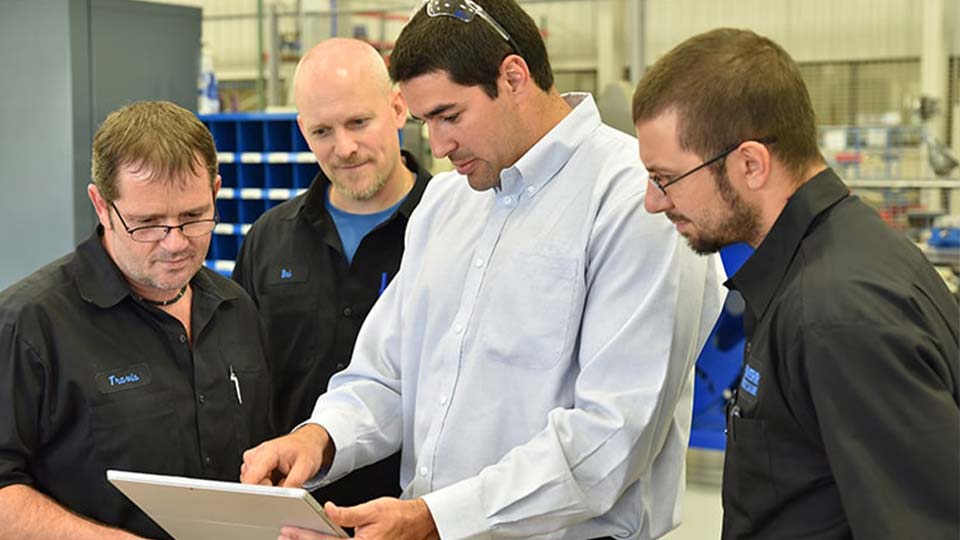Our recent ergonomics webinar, Using AI to Assess Risk and Solve Problems in Manufacturing, presented by VelocityEHS board-certified ergonomists Rick Barker and Blake McGowan, discussed the seismic transition in the manufacturing industry from Industry 4.0 (technology-driven) to Industry 5.0, which is focused on value-driven technology.
The technology that will be valuable in Industry 5.0 will include applications of Artificial Intelligence to standardize and streamline risk assessments in safety and ergonomics, such as musculoskeletal disorder (MSD) risk assessments, and objectively score the risk with accuracy. Data that used to take an experienced ergonomist hours of work to compile and analyze can be gathered, scored and interpreted to a deeper level, faster, to accurately prioritize making the improvements that improve the health of workers.
There was such great discussion in this session (now available on-demand) that our experts weren’t able answer all the audience’s questions in just an hour! So, we saved the questions we couldn’t answer live and have included them with our experts’ answers here.
To what extent does this concept comply with Poka-Yoke (a common process analysis tool used in mistake-proofing)?
- I believe it would be the same as any ergonomics assessment in this regard. Knowing what tasks don’t fit the human well, and modifying those tasks, helps to prevent errors in the process. A human factors (cognitive/sensory) evaluation probably has a more immediate and direct impact. But a mismatch between a human’s physical capabilities and the job requirements is a source of errors and defects.
So the AI utilizes multiple methodologies and then uses the lowest limiting factor to generate the score, or have you come up with your own method? For example: it assesses a task against psycho physical, biomechanical, physiological and epidemiological methods and uses the method or methods that produce the task failure points to generate a score?
- The model doesn’t run multiple analyses and select the high-risk score; rather, it has scoring thresholds and weightings that incorporate information from all of these sources.
With smart watches, is there a way to notify the employee that they’re anxious/at risk, or does it just store information to be used for incident investigations?
- This is more of a future state concept than a market-ready product. The intent is to predict hazardous conditions and alert the person and/or a supervisor before an event occurs.
Aside from Ergonomics, is there AI-aided industrial hygiene management—especially in the area that supports improving exposure assessment and impacts on health?
- There’s research underway, but nothing we have ready to share (yet). Stay tuned!
I assess a lifting task using a psychophysical method like Liberty Mutual, a physiological method like Mital or MAE, biomechanical like LC-Lift and Epidemiological like NIOSH Lifting Equation. The task passes some but not all based on your parameters like Force, Repetition and so on. Does this system do something similar and then produce a score based off the failures?
- Like with industrial hygiene management, we’re currently researching the capability, but don’t have anything to share yet.
What about Modelica Open Source?
- Modelica Open Source is an excellent tool for experts to utilize. However, it is too complex for the site ergonomics team to utilize.
How do we define data related to ergonomics?
- Data related to ergonomics typically is associated with the following categories: (Data from each group is required to conduct a detailed evaluation of the ergonomics condition of the workstation.)
- Human performance capabilities (e.g., functional reach distances and force- generating capabilities for the full range of the working population;
- Static workstation dimensions (e.g., heights and reach distances);
- Dynamic job demands (e.g., force, cognitive, and production requirements).
- Data from each group is required to conduct a detailed evaluation of the ergonomics condition of the workstation.
Regarding the Automated Lessons Learner with artificial intelligence, to proceed we need a large database of incidents with their details. How do we ensure we have such a database to start with?
- Because we have a large set of historical data covering many types of operations, we have a good basis for training the models. The process of suggesting a lesson learned, rather than automatically sending that lesson, provides the opportunity to align those lessons with the specifics of an organization. Organizational size (and number of incidents) would likely be a factor in the degree to which future learning of the model will be able focus those to an individual company.
Who should own this AI data (used for ergonomics assessments)?
- Some of the most effective ergonomics processes are run by people who don’t have a traditional EHS or industrial hygiene background. The best owners in an organization can depend on that organization. Continuous Improvement leaders inherently understand the ergonomics improvement process and are a good owner for making the process successful. When many of the ergonomics improvements can only be made as new equipment or processes are being implemented, ergonomics is often effectively led by engineering. Regardless of who owns it, there needs to be an alignment of accountability with the responsibility.
To see the full webinar and hear the whole discussion, watch the on-demand recording now. Then, take a look through our library of on-demand webinar recordings for more valuable EHS content and information.
To learn more about the technology powering more accurate risk assessments, check out VelocityEHS Industrial Ergonomics, the smarter way for world-class companies to assess and control MSD risk in the workplace.
